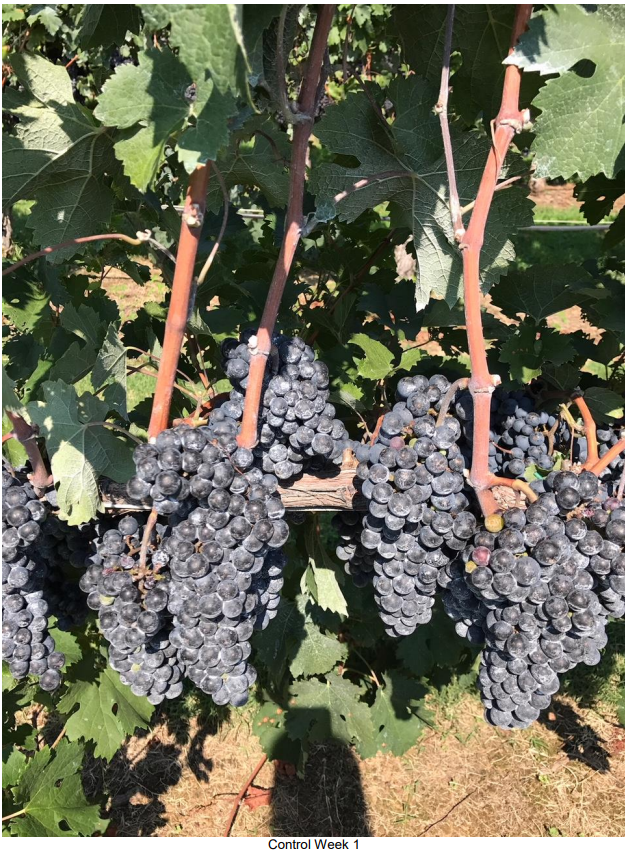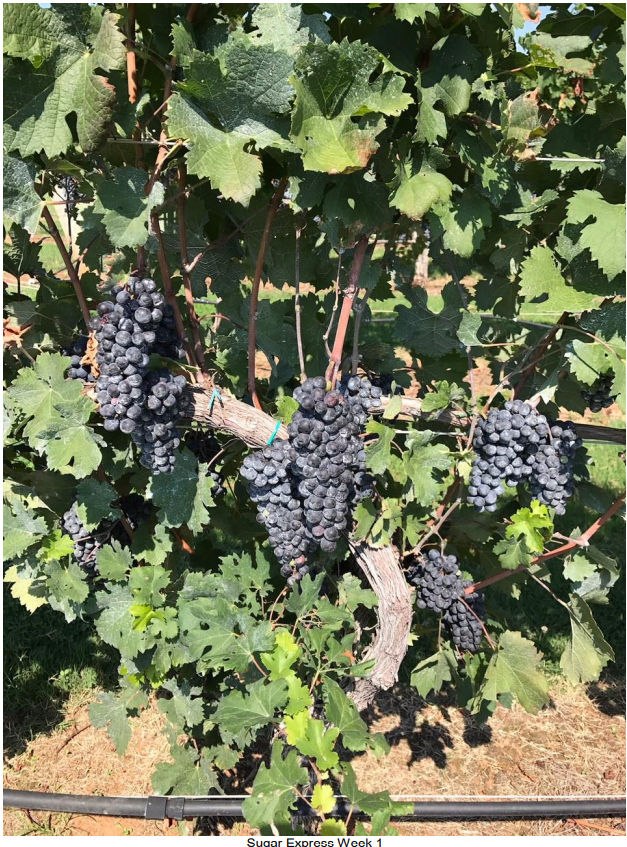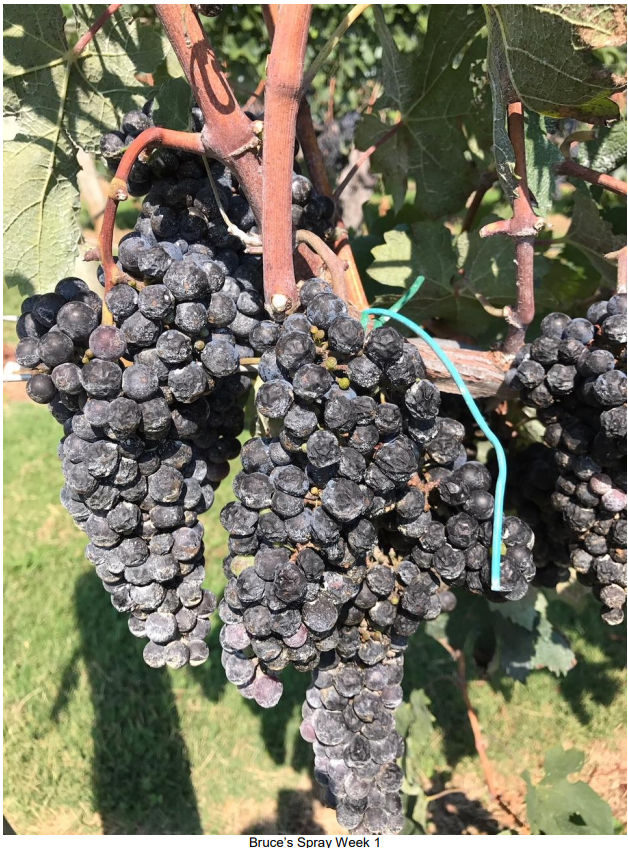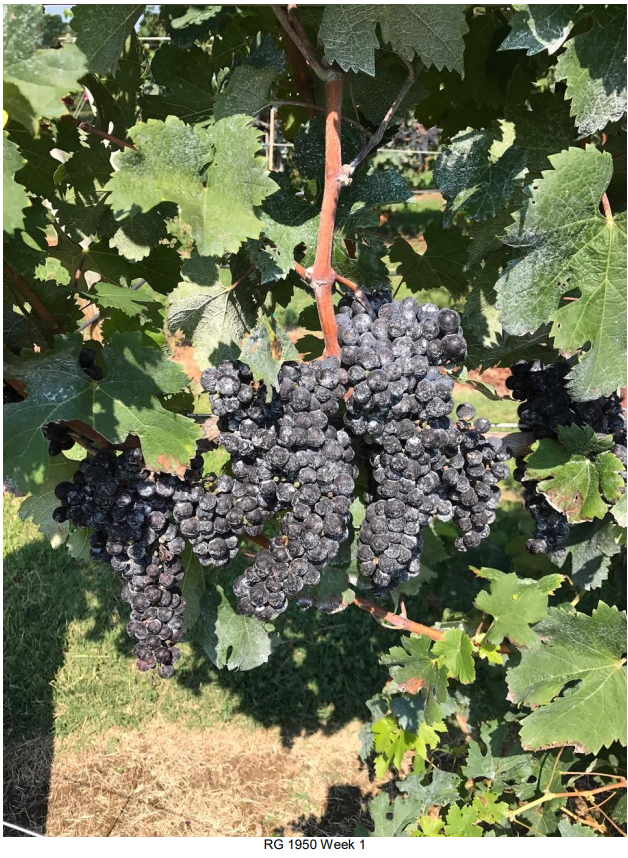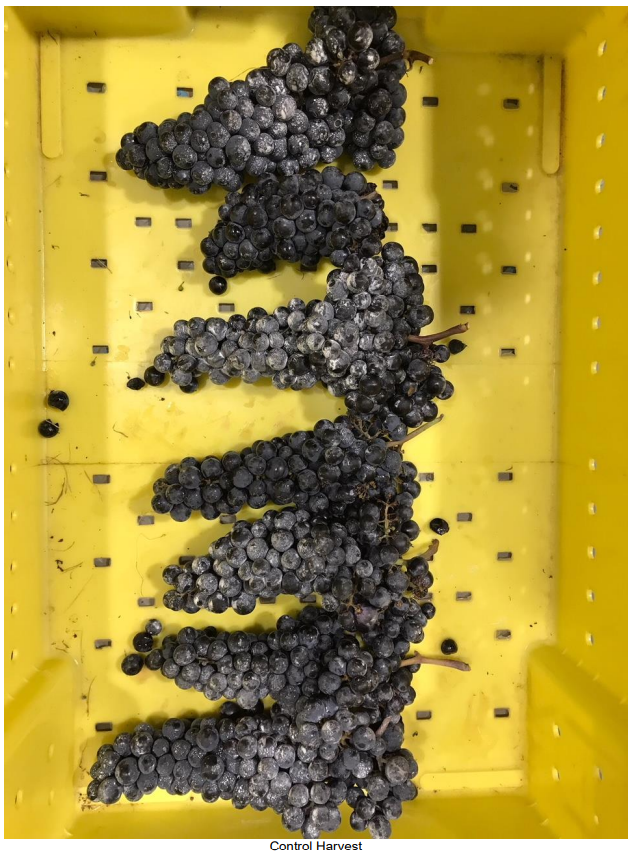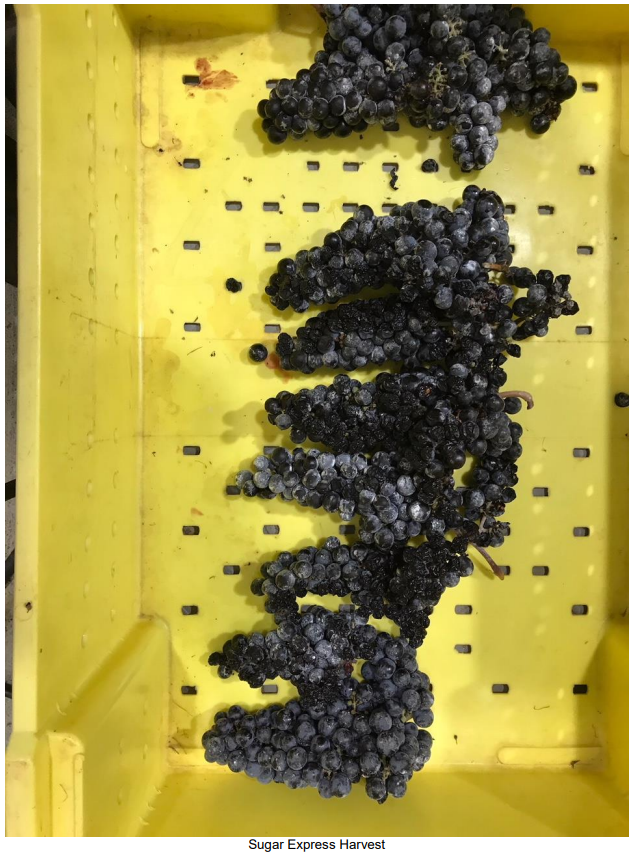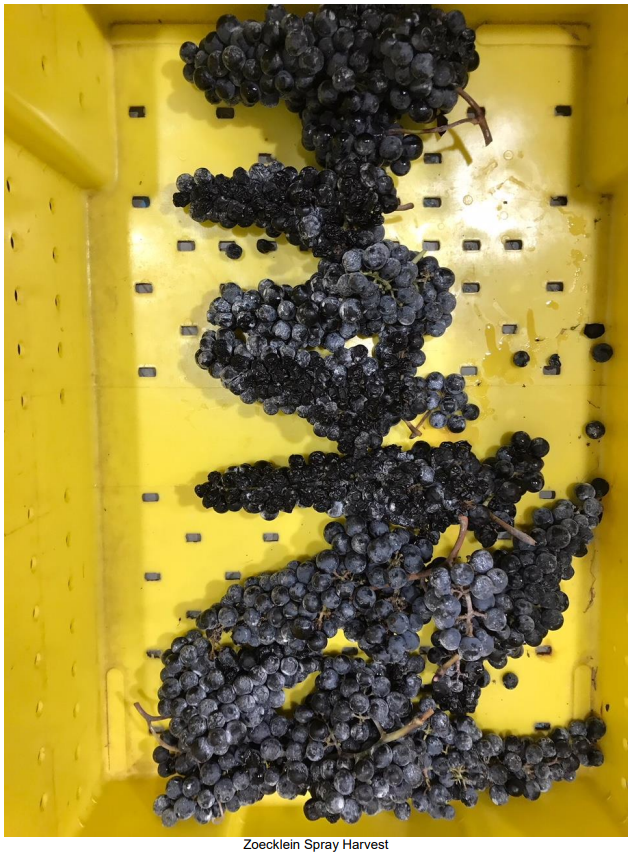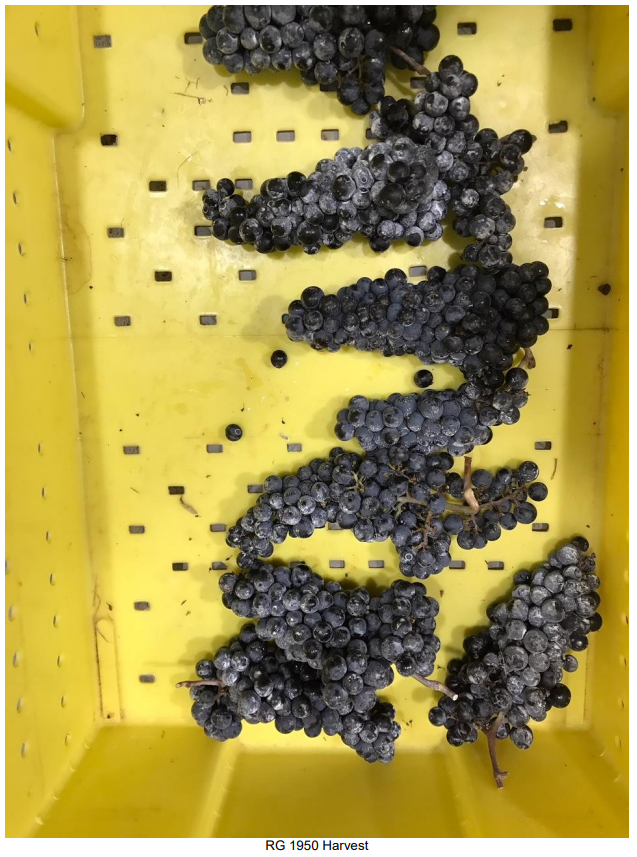Vineyard Desiccation Sprays to Improve Ripening in Merlot (in collaboration with VT) (2017)
Matthieu Finot
King Family Vineyards
Summary
This study examines the impact of different desiccation sprays on the resulting juice and wine chemistry of Merlot. 8 rows of Merlot from the same block were divided into 4 pairs, each pair of rows receiving a different treatment. The following treatments were performed: 1) Control (no spray), 2) RG 1950 spray in collaboration with Dr. Mizuho Nita, where rows were sprayed 4 times weekly, over four weeks, starting from veraison, 3) VT Tech Dehydration spray in collaboration with Dr. Bruce Zoecklein, where rows were treated on the fruit zone at approximately 19 degrees Brix using a 2% solution of methyl esters of fatty acids in a 2% solution of potassium carbonate in water, and 4) Sugar Express (Miller Chemical) Spray (4-10-40 Nitrogen-Phosphate-Potash), where rows were treated on the full canopy at approximately 19 degrees Brix at 10 lbs/acre. All other viticultural and winemaking practices were equal. Grapes were harvested on September 20, after processing musts were inoculated with D21, and each fermentation received a 16 day maceration. The two VT sprays had the greatest impact on Brix and Average Berry weight during ripening. Fluctuations are due to rain events around September 2 and September 6. The VT sprays produced juice with higher Brix, although the Zoecklein spray had higher TA and the RG 1950 had lower TA. Wine chemistry showed higher ethanol for these two sprays, higher TA and tartaric acid for all three sprays, and lower levels of lactic acid. Color intensity was increased by the desiccation sprays. Anthocyanins were slightly lowered for the VT sprays, although polymeric anthocyanin was increased for these sprays. Tannin showed slight increases for these sprays as well. These phenolic differences, however, were not very great.
Overall, the desiccation sprays had a tendency to lower the Herbaceous character of the wines. Overall Aromatic Intensity and Body tended to be increased by the Zoecklein spray, although RG 1950 also had a slight tendency to increase Body. These two sprays also had a slight tendency to increase Fruit Intensity, although this was weak. In general, the control wine was more similar to the Sugar Express treatment, and the two Virginia Tech desiccation sprays were more similar to each other. Preference trends were hard to determine, but the Sugar Express treatment tended to be less preferred. The two Virginia Tech desiccation sprays were perhaps slightly more preferred control when considering that these two wines were fairly similar to each other. These results suggest that desiccation sprays may be a valuable tool in Virginia winemaking, and studies like these merit more rigorous analysis, especially with regard to sensory attributes of the wines. These studies should be continued to be repeated, on multiple varieties over multiple vintages.
Introduction
In regions with common rainfall, ripening problems may occur due both to dilution from rain as well as from forced early harvest to avoid excessive disease pressure. As such, crop management techniques provide a key tool to enhance ripening kinetics and reduce disease pressure. One such method for crop management involves crop desiccation. Desiccation naturally concentrates several ripeness factors in grape berries, and often enhances grape respiration resulting in lower malic acid. Crop desiccation occurs naturally in regions with low rainfall but is generally impeded by rain. This study examines the impact of a desiccation spray on the chemical and sensory qualities of Merlot.
Results and Discussion
The two VT sprays had the greatest impact on Brix and Average Berry weight during ripening. Fluctuations are due to rain events around September 2 and September 6. The VT sprays produced juice with higher Brix, although the Zoecklein spray had higher TA and the RG 1950 had lower TA. Photographs of the clusters can be found in the supplemental data.
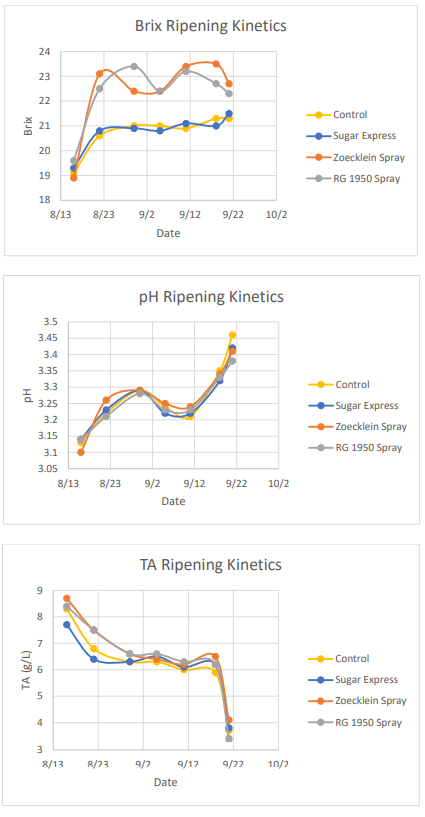
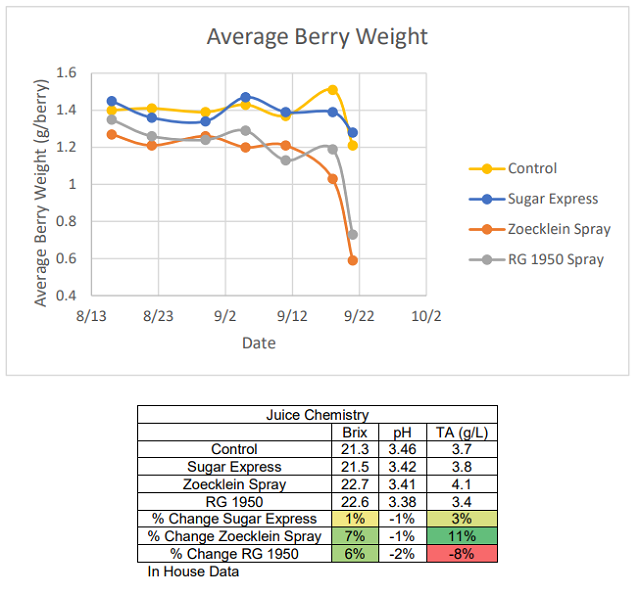
Wine chemistry showed higher ethanol for the two Virginia Tech sprays, higher TA and tartaric acid for all three sprays, and lower levels of lactic acid. Color intensity was increased by the desiccation sprays. Anthocyanins were slightly lowered for the VT sprays, although polymeric anthocyanin was increased for the sprays. Tannin showed slight increases for these sprays as well. These phenolic differences, however, were not very great.
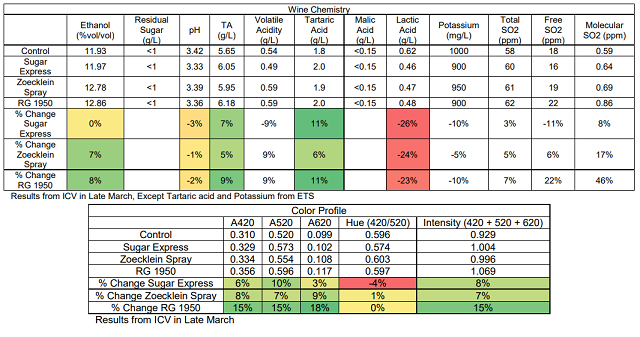
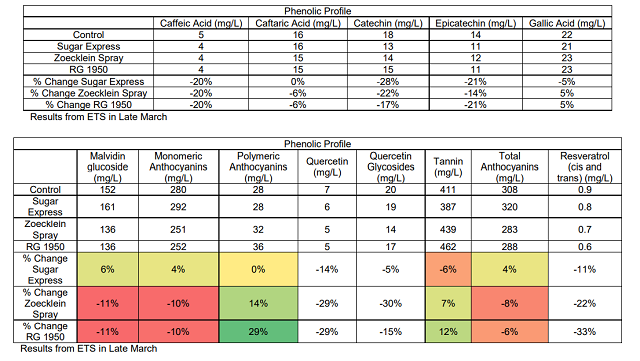
For the descriptive analysis on May 16, there was a strong trend for the Control to have higher Herbaceous/Green qualities than the treatments and for the Zoecklein spray to be lowest in this regard, for the Zoecklein spray to have highest Overall Aromatic Intensity and the Sugar Express treatment to be lowest in this regard, and for the Zoecklein spray to have higher Body (LSD=0.33 for Herbaceous/Green, LSD=0.42 for Overall Aromatic Intensity, and LSD=0.62 for Body).
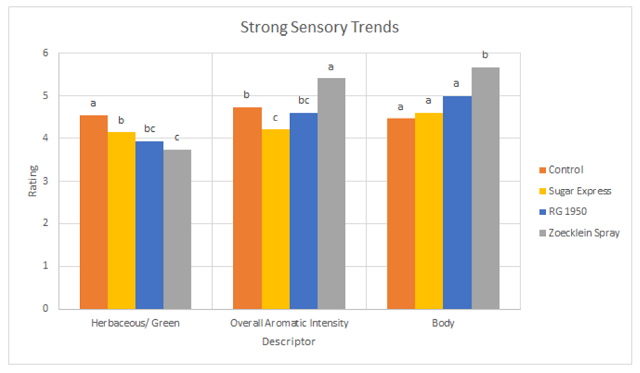
There was a slight tendency for the RG1950 spray to have higher Fruit Intensity, and for the Sugar Express to have lower Fruit Intensity. There was a slight tendency for the Zoecklein spray to have lower Acidity. There was a slight tendency for RG 1950 to have lower Astringency and Herbaceous/Green character, and to have higher Body (but not as high as the Zoecklein spray). In general, the most preferred wine tended to be the Zoecklein Spray, followed by RG 1950. The wine made with Sugar Express tended to be least preferred.
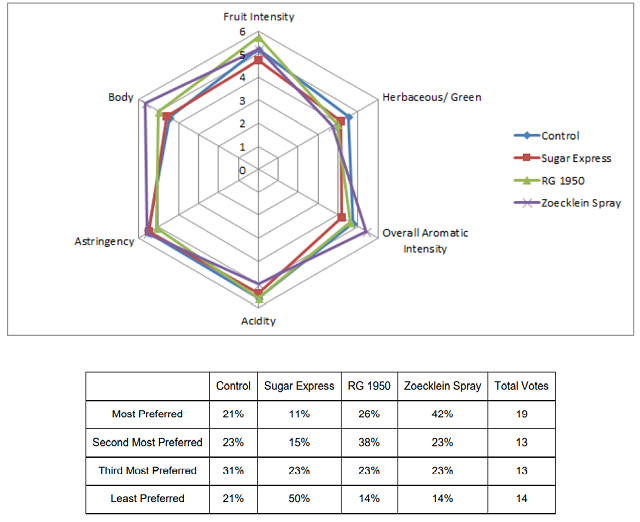
For the descriptive analysis on May 30, there was a strong trend for the RG 1950 treatment to have higher Body than the Sugar Express and Zoecklein spray treatments, but not compared to the control (LSD=0.36). There was a slight tendency for Fruit Intensity and Acidity to increase with the sprays. Besides the RG 1950 spray, there was a slight trend for the other sprays to lower Body. However, these trends were all very weak. All wines were preferred fairly similarly to each other in this tasting, perhaps with a slight preference towards the Control and the RG 1950 treatment. If so, however, this was very weak.
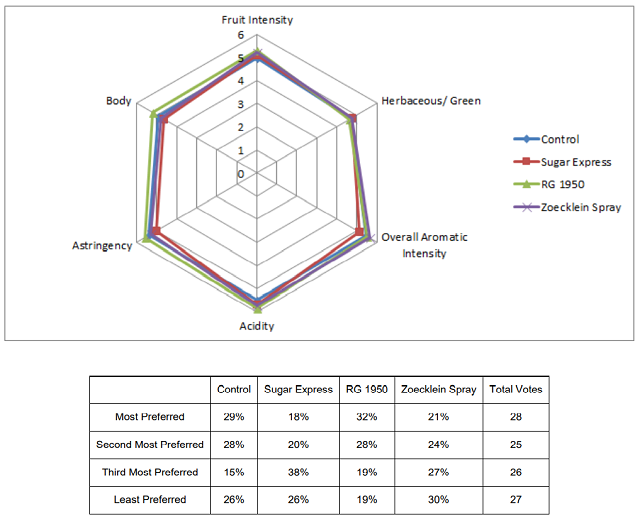
Overall, the desiccation sprays had a tendency to lower the Herbaceous character of the wines. Overall Aromatic Intensity and Body tended to be increased by the Zoecklein spray, although RG 1950 also had a slight tendency to increase Body. These two sprays also had a slight tendency to increase Fruit Intensity, although this was weak. In general, the control wine was more similar to the Sugar Express treatment, and the two Virginia Tech desiccation sprays were more similar to each other. Preference trends were hard to determine, but the Sugar Express treatment tended to be less preferred. The two Virginia Tech desiccation sprays were perhaps slightly more preferred control when considering that these two wines were fairly similar to each other. These results suggest that desiccation sprays may be a valuable tool in Virginia winemaking, and studies like these merit more rigorous analysis, especially with regard to sensory attributes of the wines. These studies should be continued to be repeated, on multiple varieties over multiple vintages.
Methods
8 rows of Merlot from the same block were divided into 4 pairs, each pair of rows receiving a different treatment. Each pair of rows corresponds to 0.3 acres. The following treatments were performed:
- Control (no spray)
- Sugar Express (Miller Chemical) Spray (4-10-40 Nitrogen-Phosphate-Potash): Rows were treated on the full canopy at approximately 19 degrees Brix at 10 lbs/acre
- VT Tech Dehydration spray in collaboration with Bruce Zoecklein. Rows were treated on the fruit zone at approximately 19 degrees Brix using a 2% solution of methyl esters of fatty acids in a 2% solution of potassium carbonate in water. Spray was done with backpack sprayer. Clusters were coated to dripping and left to hang until target harvest Brix is obtained.
- RG 1950 spray in collaboration with Mizuho. Sprayed 4 times weekly, over four weeks, starting from veraison.
All other treatments between rows were equal. There were two rain events, around September 2 and September 6. Grapes were harvested on September 20, 2017 and refrigerated overnight. On September 21, grapes were processed into separate T Bins, and 30ppm sulfur dioxide was added to each T Bin. The following day, 0.05g/L Lafase HE Grand Cru was added, and the musts were then inoculated with 0.17g/L D21. On September 24, 15g/hL Fermoplus Premier Cru was added. Wines were pressed on October 6 (~16 days of maceration) into tank, settled overnight, and then racked into identical neutral barrels the following day. After completion of malolactic conversion, 66ppm sulfur dioxide and 3.33g/hL Stab Micro M was added to the wines. This occurred for the control and Sugar Express on December 1, for RG 1950 on January 24, and for Bruce’s treatment on January 5.
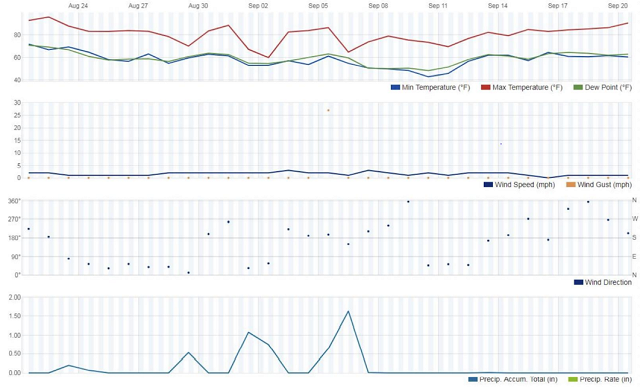
These wines were tasted on May 16 and May 30. In order to balance the data set to perform statistical analysis for descriptive analysis on the May 16 tasting, any judge who had not fully completed the descriptive analysis ratings were removed. In order to then make the number of judges between groups equivalent, two judges from group 1 was transferred to group 3, and another judge from group 2 was eliminated. This resulted in a final data set of 3 groups, each with 5 judges (considered as replications within groups, and groups were considered as assessors). Data was analyzed using Panel Check V1.4.2. Because this is not a truly statistical set-up, any results which are found to be statistically significant (p<0.05) will be denoted as a “strong trend” or a “strong tendency,” as opposed to general trends or tendencies. The statistical significance here will ignore any other significant effects or interactions which may confound the results (such as a statistically significant interaction of Judge x Wine confounding a significant result from Wine alone). The descriptors used in this study were Fruit Intensity, Herbaceous/Green, Overall Aromatic Intensity, Acidity, Astringency, and Body.
The same procedures for data analysis were used on the May 30 tasting. For the descriptive analysis in this tasting, two judges were eliminated from group three so that each group had seven judges, for a total of 21 judges.
Supplemental Data
